In the world of football management, few names command as much attention and curiosity as Ange Postecoglou. Known for his innovative and dynamic tactical approach, Postecoglou has taken the reins at Tottenham, ushering in a new era for the North London club. This tactical analysis delves into the strategic intricacies and stylistic nuances that define Postecoglou’s approach with Tottenham. From build-up strategies to defensive transitions, we unravel the tactics that the Australian manager and his team are perfecting on the pitch. Join us in dissecting the fascinating tactical evolution unfolding under the guidance of Ange Postecoglou at Tottenham.
Build-up
Low Build-up
In the low build-up, Postecoglou sets his team up in a 3-3-5 formation. The goalkeeper acts as a center-back, and the fullbacks invert, coming into the midfield.
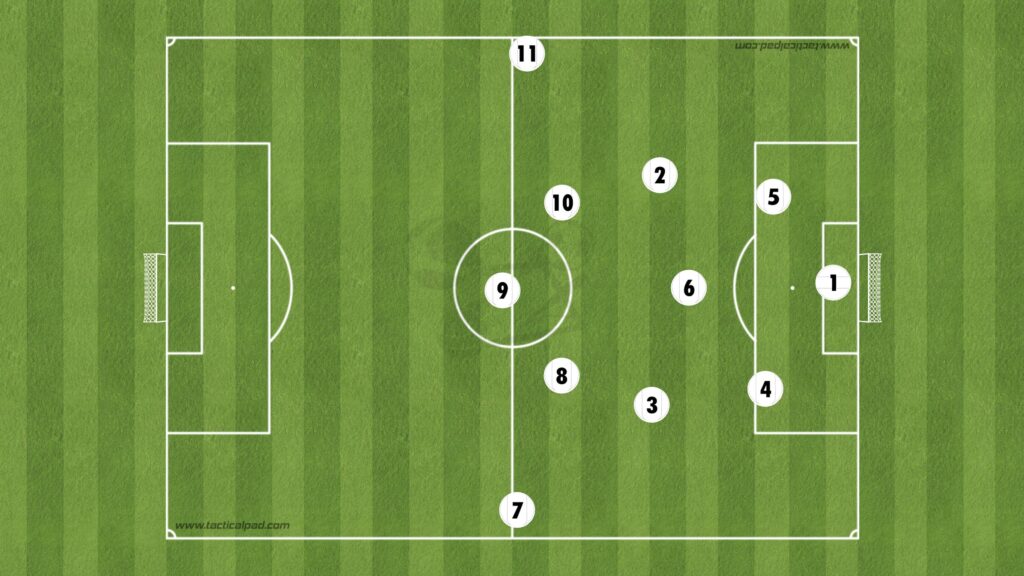
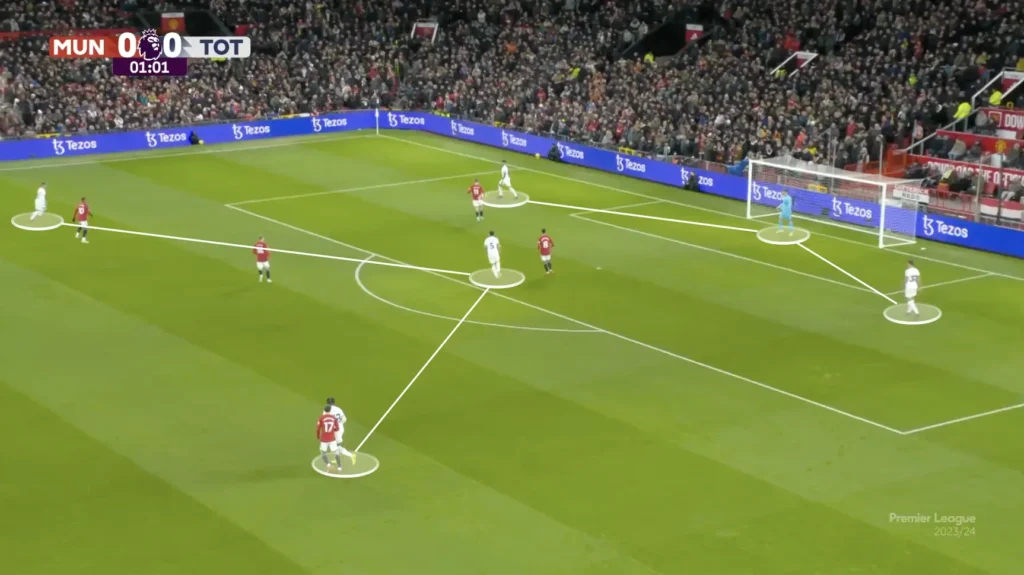
Many Tottenham players often drop very low in this phase of the game. This often creates numerical advantages, allowing Tottenham to beat the press and progress up the pitch. If the opposition follows the dropping players, space will open up behind the midfield line, creating opportunities for Tottenham’s individually strong attackers to play 1v1 against their defender.
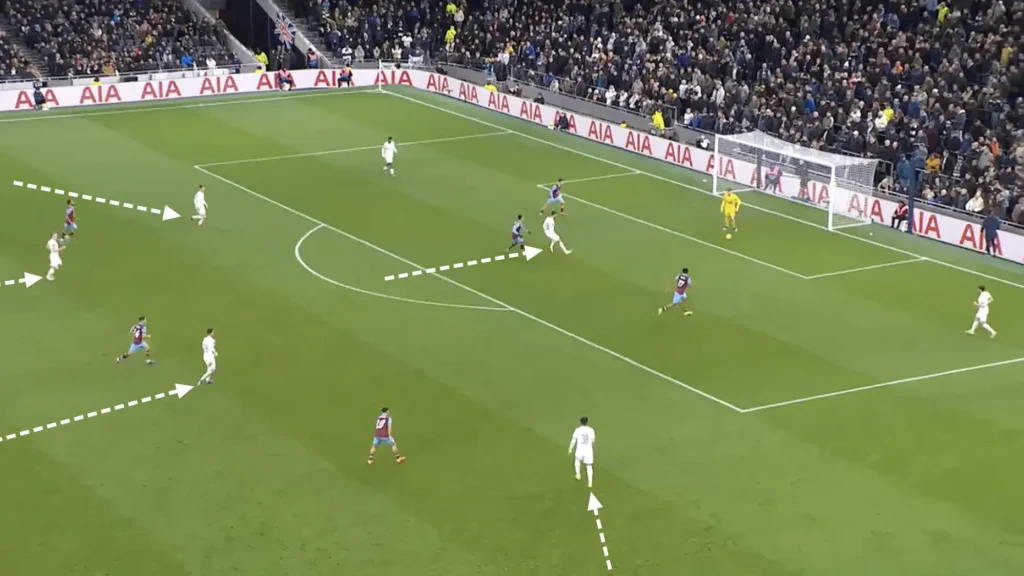
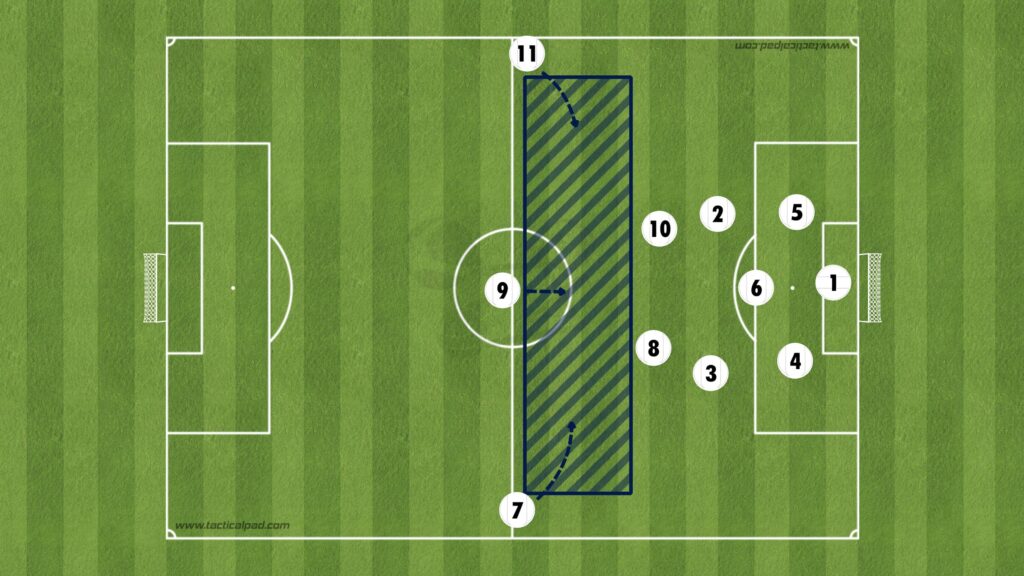
Inverted Fullbacks
The Tottenham fullbacks, as established, invert during the build-up, creating more options in the center and less space between the players. Postecoglou likes this because he prioritizes playing through the middle. He needs one player high and wide to pull apart the backline while the rest create numerical advantages in the midfield areas. This builds good conditions in defensive transitions, allowing more players to press when they lose the ball. Another purpose for keeping the majority of the players in the middle is that it lessens the distance between the players. This shortens the length of the passes, which naturally shortens the time between passes. This means the opposition players will have less time to push up and press, giving the Tottenham players more time and control.
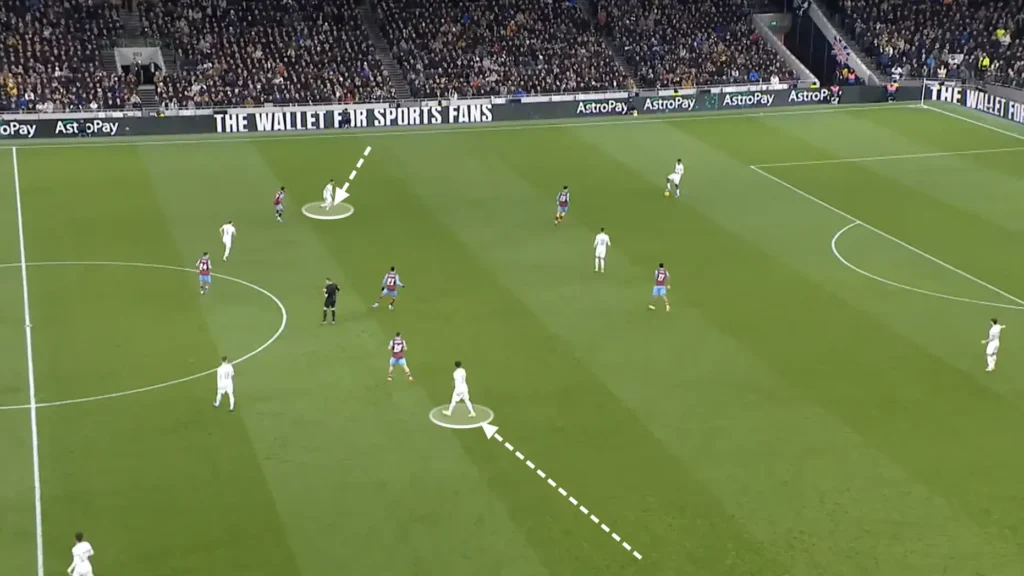
Another aspect of having the inverted fullbacks is that it opens the space out wide. A midfielder can drop into that space, losing his man, and receive a pass from the center-back, enabling him to turn and progress the ball forward.
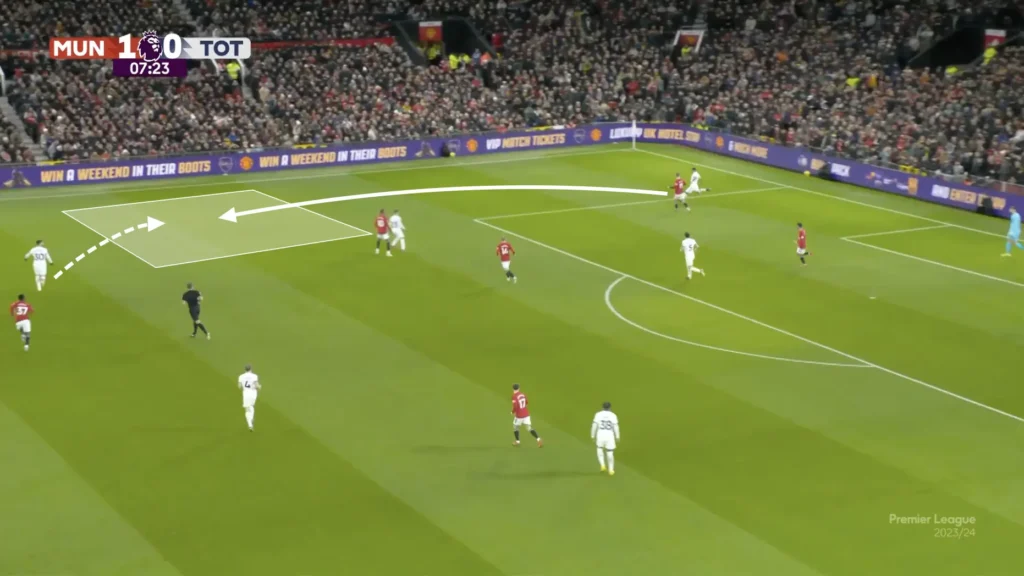
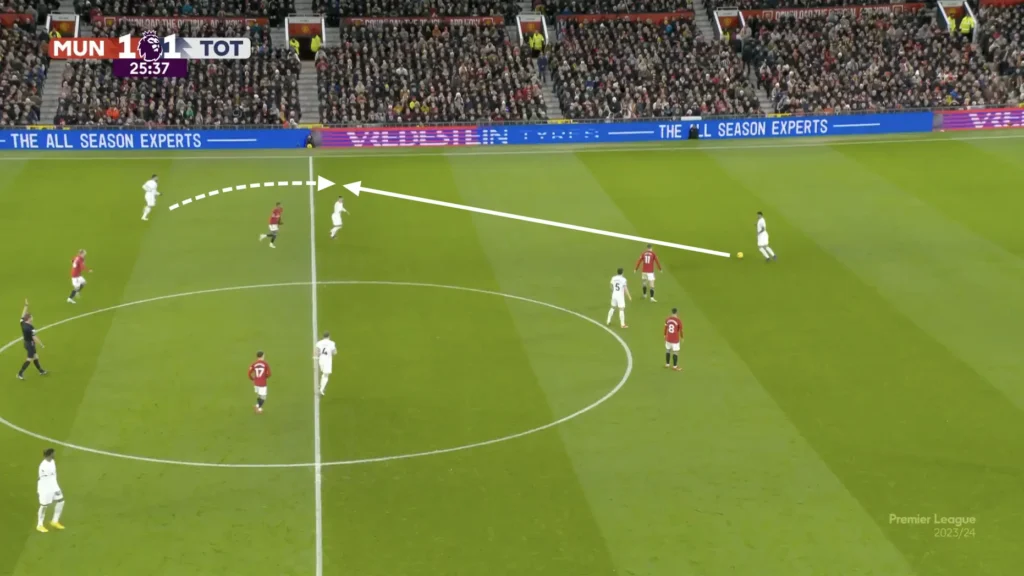
High Build-up
In the high build-up, Postecoglou’s Spurs sets up in a 1-2-3-5 formation, the same as in the low build-up without the goalkeeper between the center-backs:
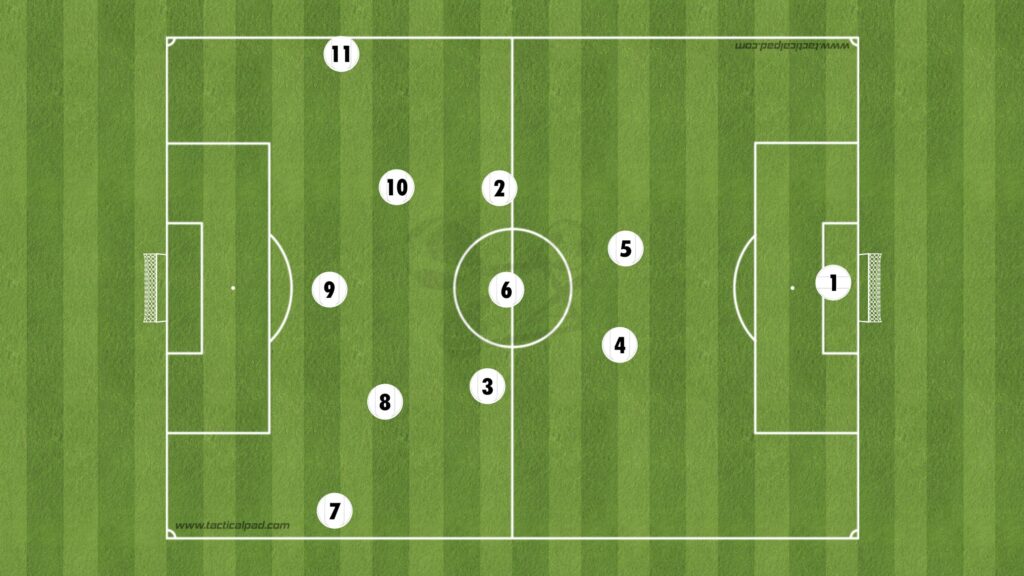
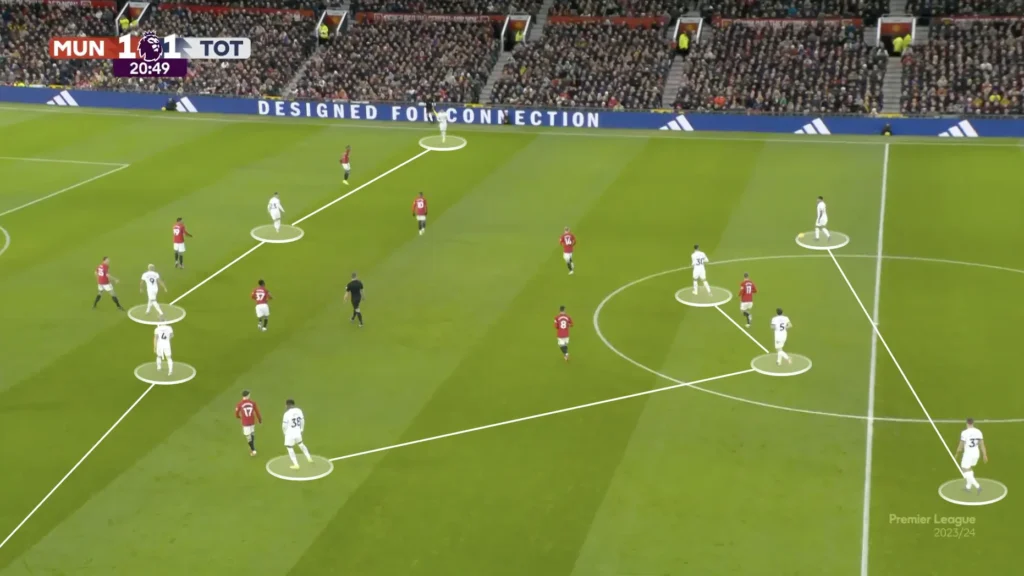
They sometimes even rotate into a 1-2-2-3-3 formation, pushing more players forward in between the lines. Postecoglou mainly carries out this tactical detail when the opposition drops with many players very low. Building with 2+3 becomes excessive if the opponent only presses with one or two players.

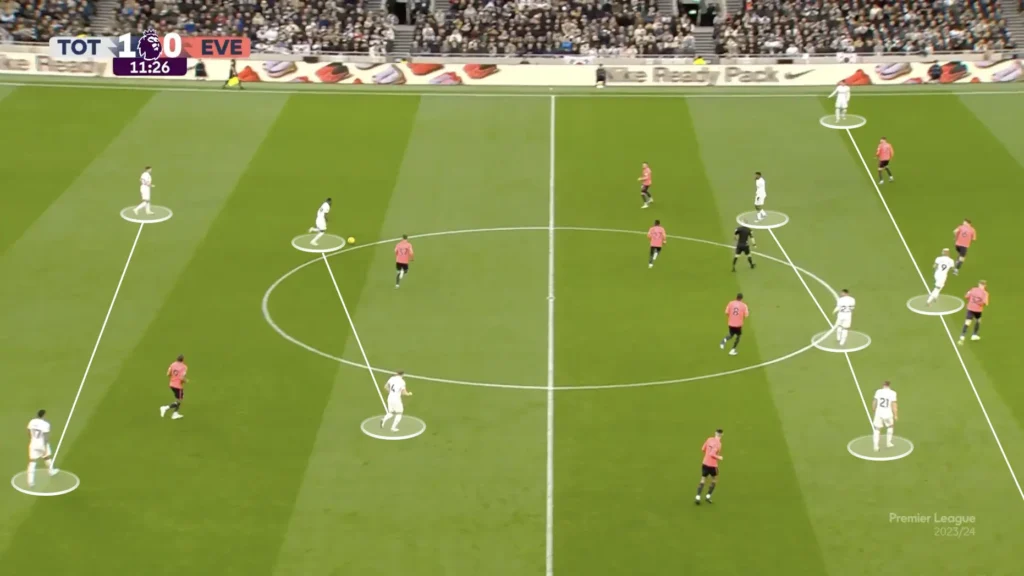
Final Third
Attacking the Half-Space
Tottenham is an excellent team in the final third. They always create many chances, mainly by attacking the space between the opposition center-back and fullback.
They mostly do this from the wide areas with underlaps from midfielders:
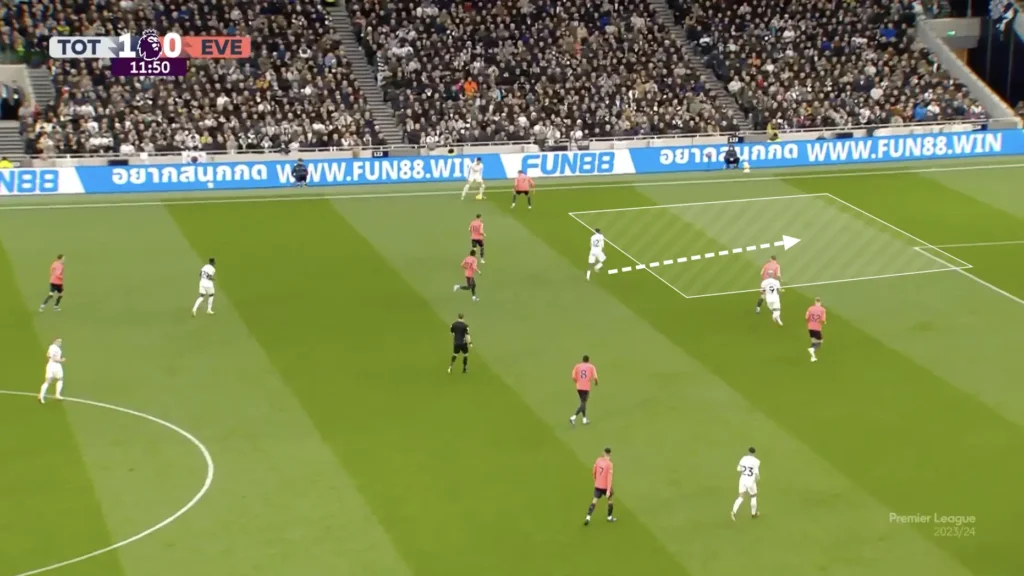
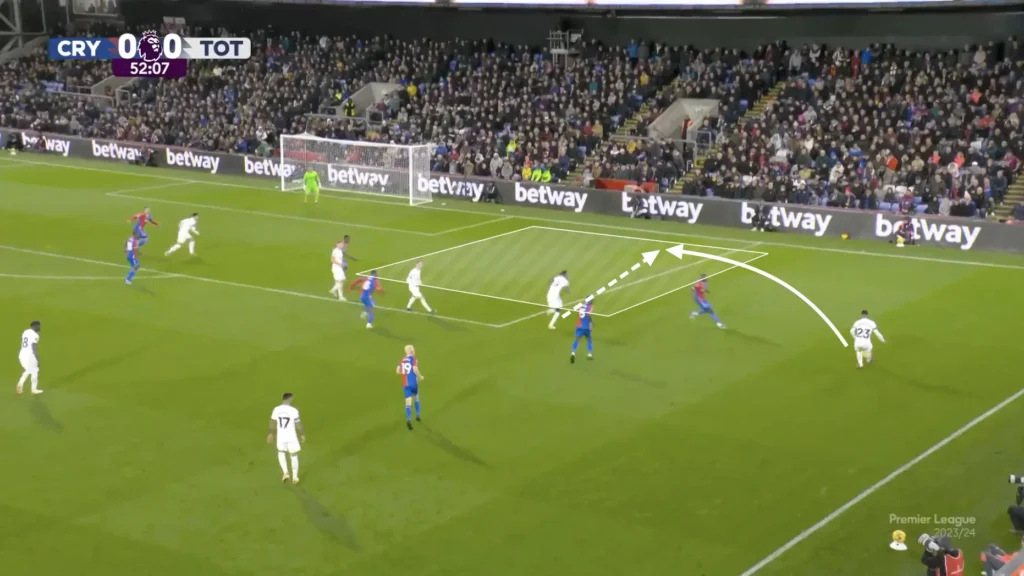
But they also do it with passes to a running winger from the midfield:
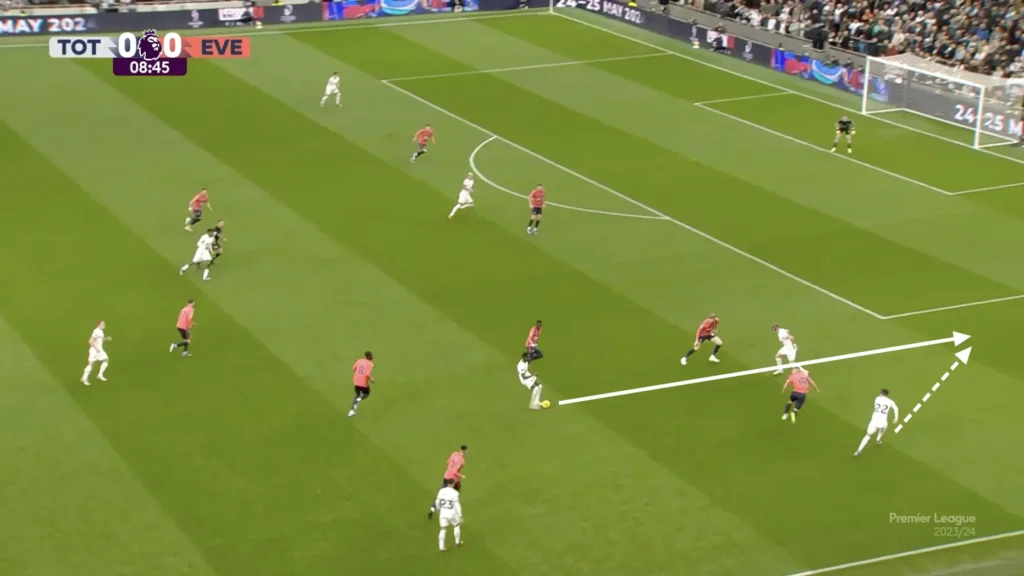
Here, the center-back follows the underlap from the midfielder. This opens up the space in the middle, which shows the effectiveness of this movement. Whatever the center-back does, there will be space for Tottenham to exploit.
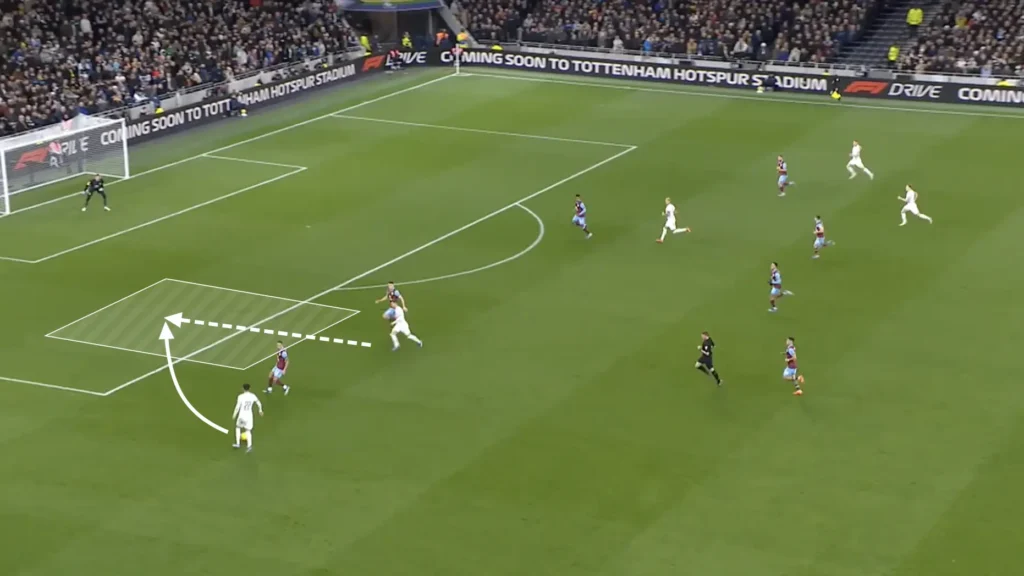
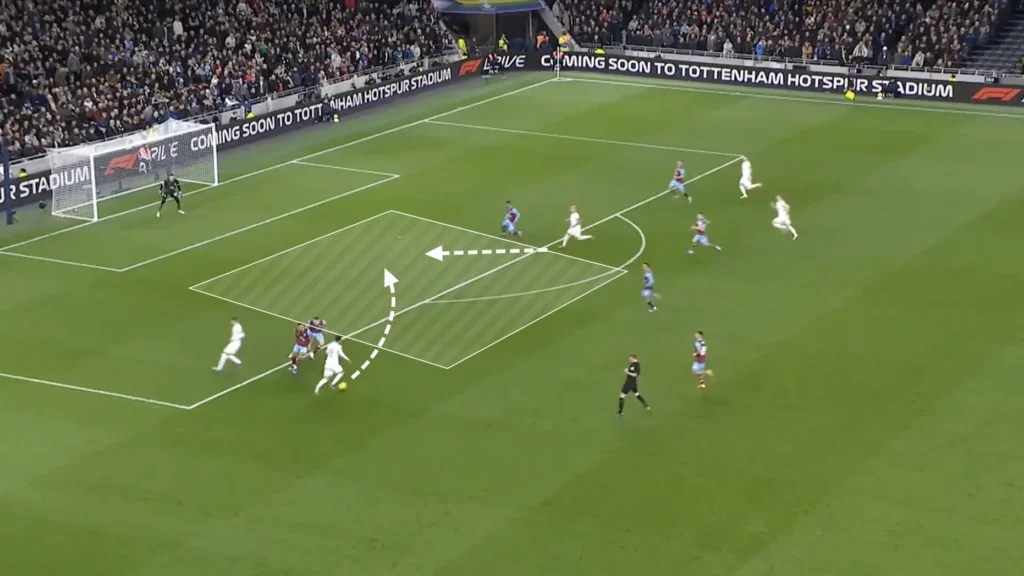
Numerical Advantages
Another massive aspect of Tottenham’s high build-up is their ability to create numerical advantages against the opposition’s defensive line. Tottenham’s front five naturally becomes numerically superior against a back four, which they are great at taking advantage of.
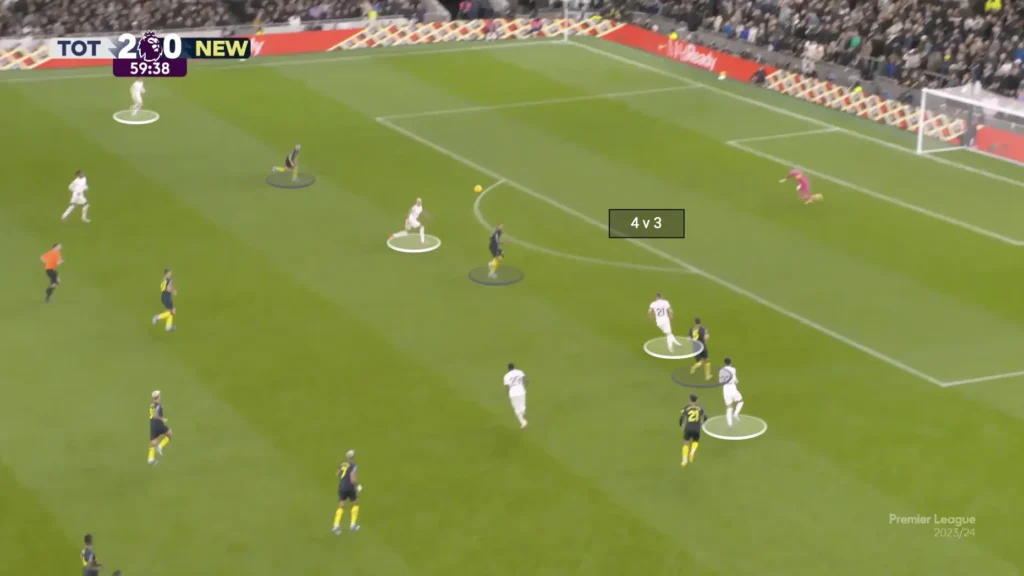
When the defending team is positioned on one side, the weak-side fullback becomes vulnerable to the long switch of play due to the 1v2 against Tottenham’s winger and attacking midfielder. Postecoglou’s team often capitalizes on this by getting the ball to the winger and creating many opportunities from 2v1 situations on the wing and in the half-spaces.
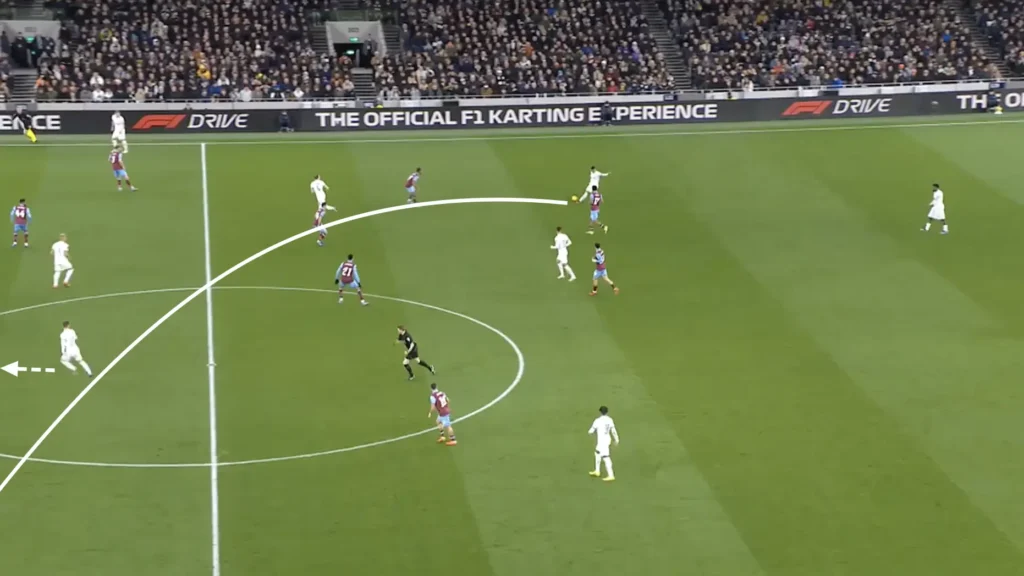
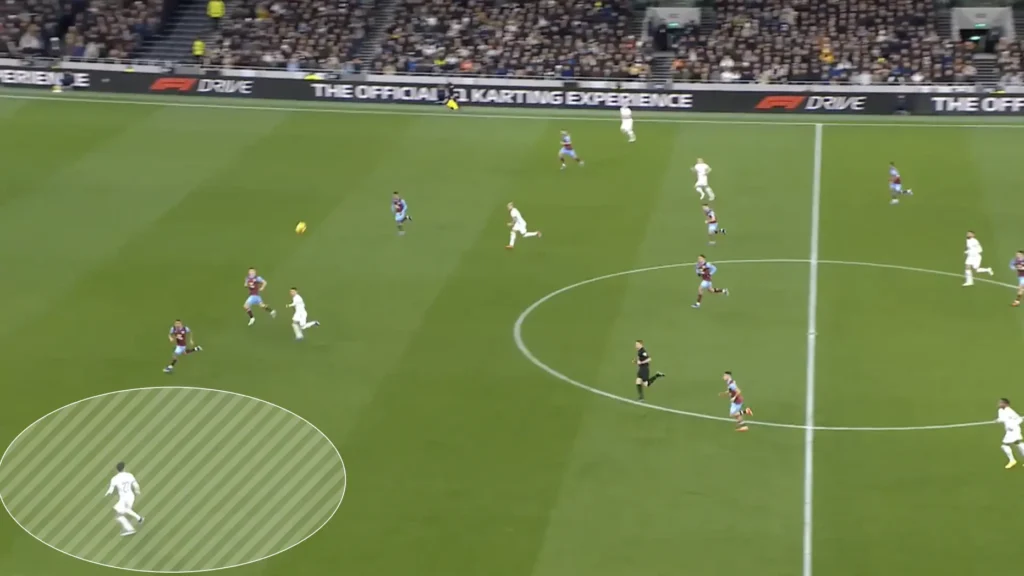
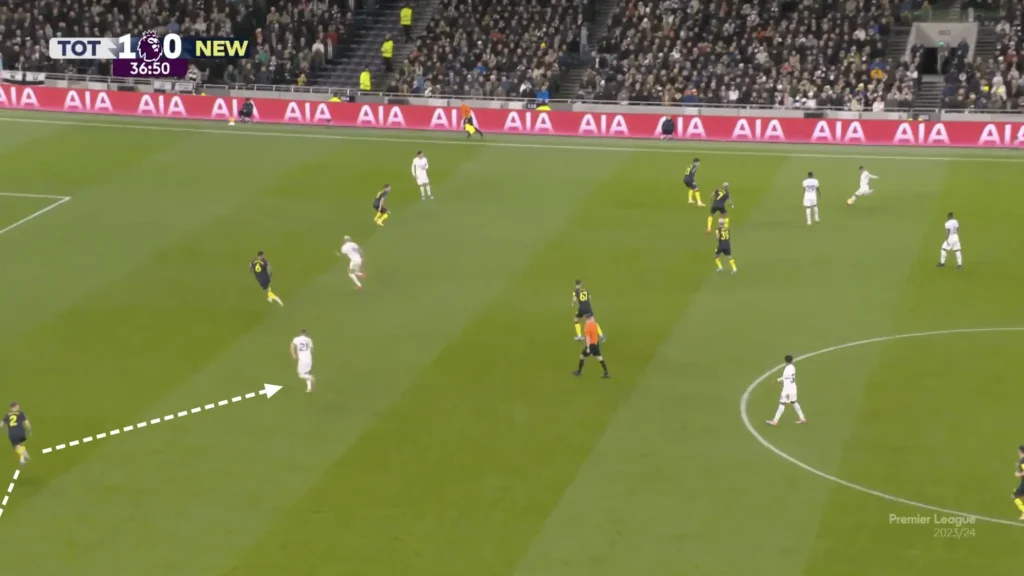
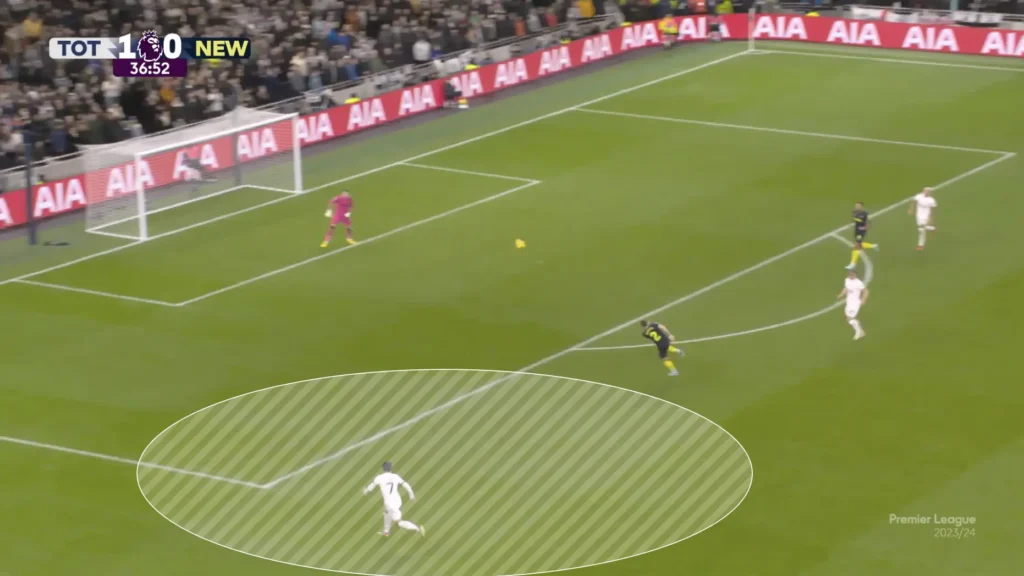
Always Ahead of the Defender
One last thing that makes Tottenham stand out is their ability to always be ahead of their defender in crossing situations. The Tottenham attackers often position themselves slightly offside and behind the opposition’s defensive line during the build-up. When the ball gets played out wide, the attacker is already in front of the defenders, allowing him to arrive first in the box and receive the cross for a great goalscoring opportunity. This is extremely hard to defend against and has given Tottenham many goals this season.
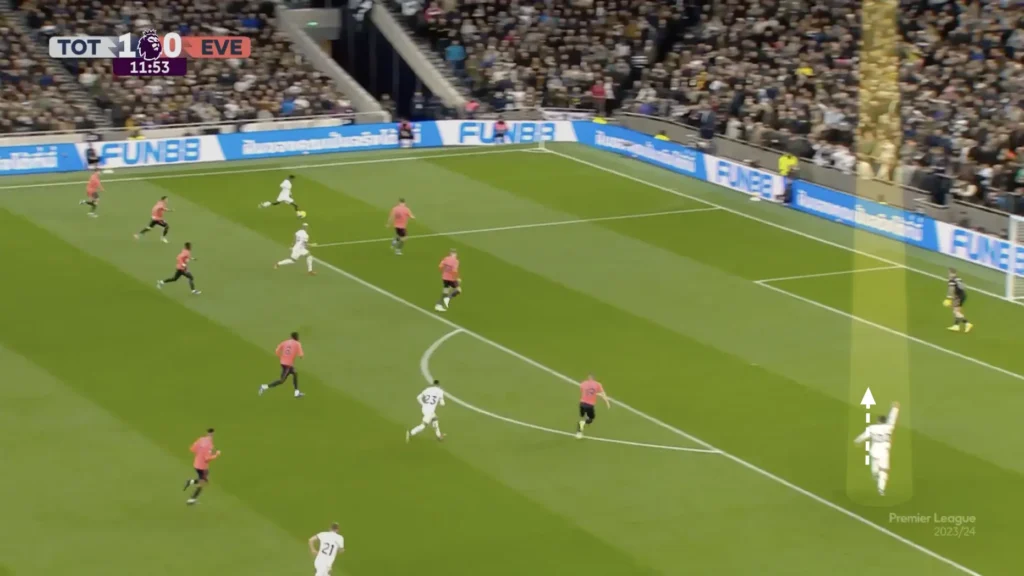
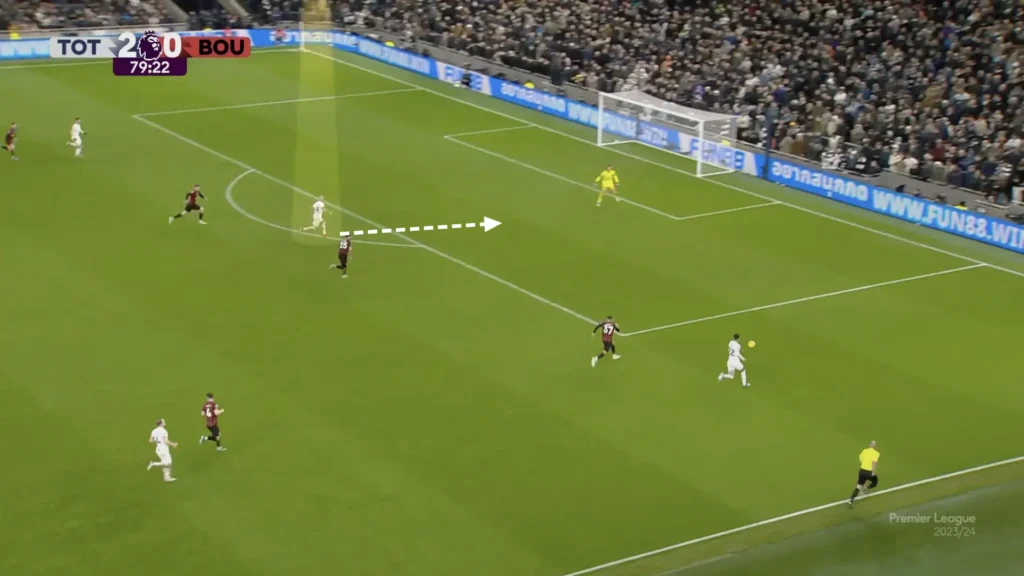
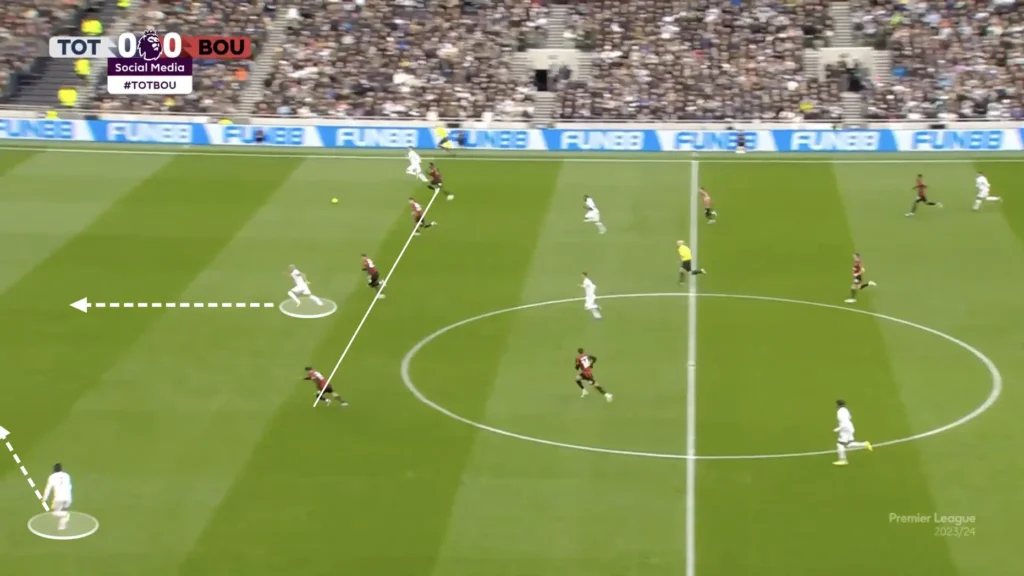
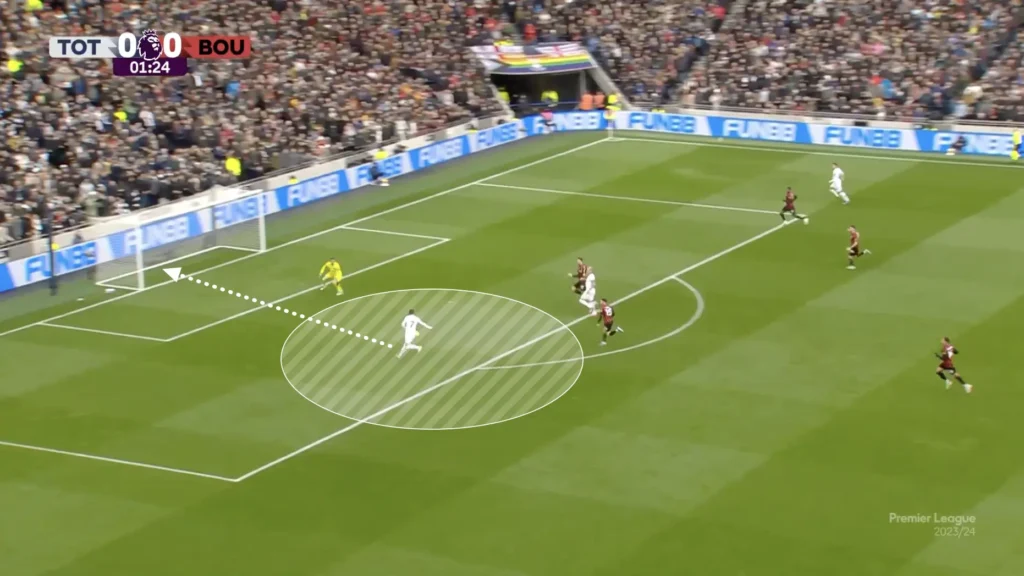
Principles and Tools
Rotations and Interchanges
Ange Postecoglou has repeatedly shown that he wants his team to play attacking and offensive football, regardless of the opposition. They like keeping possession and are often successful in doing so. One influential principle in doing this is to be fluid within the system and to find different interchanges and rotations. Their most frequent rotation is when the players in the half-space switch places to pull their defenders away and create more space and confusion. This often frees up the space for the number six, allowing him to take the ball forward with time.
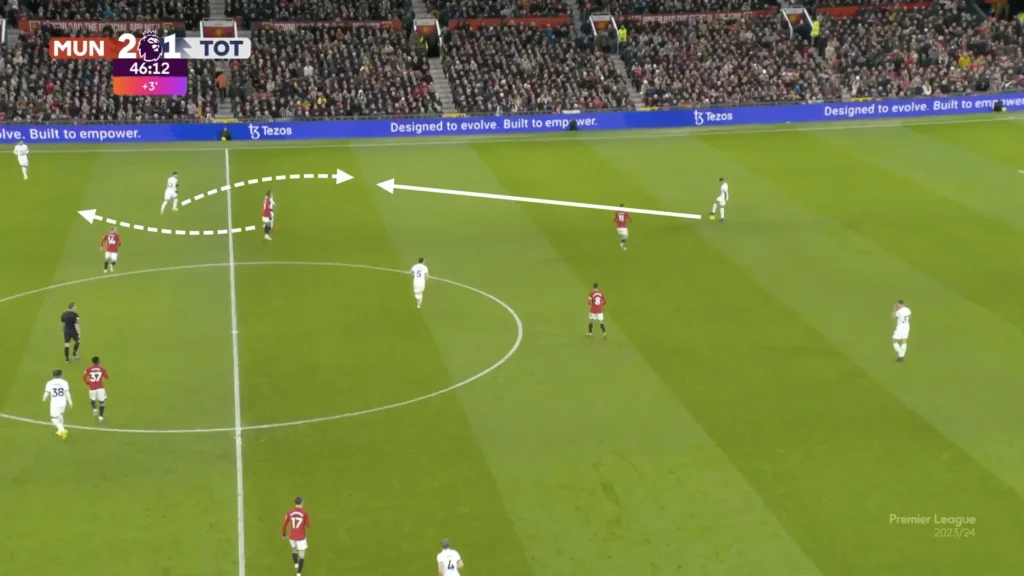
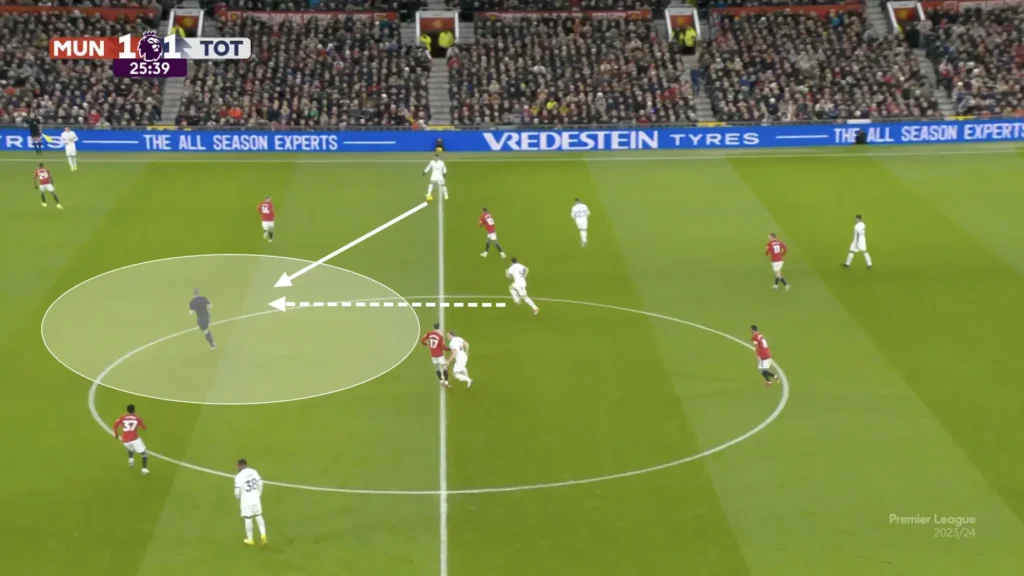
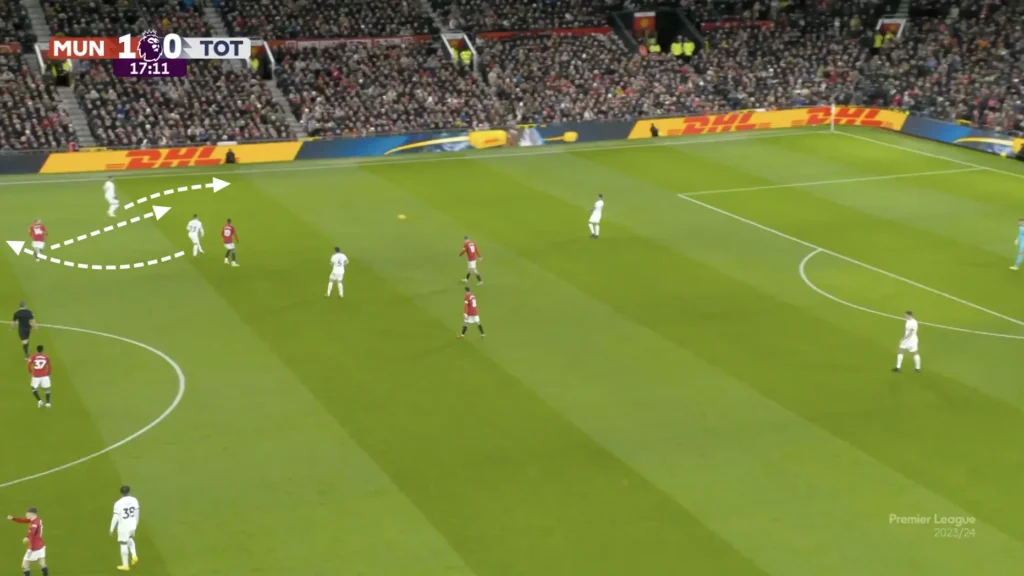
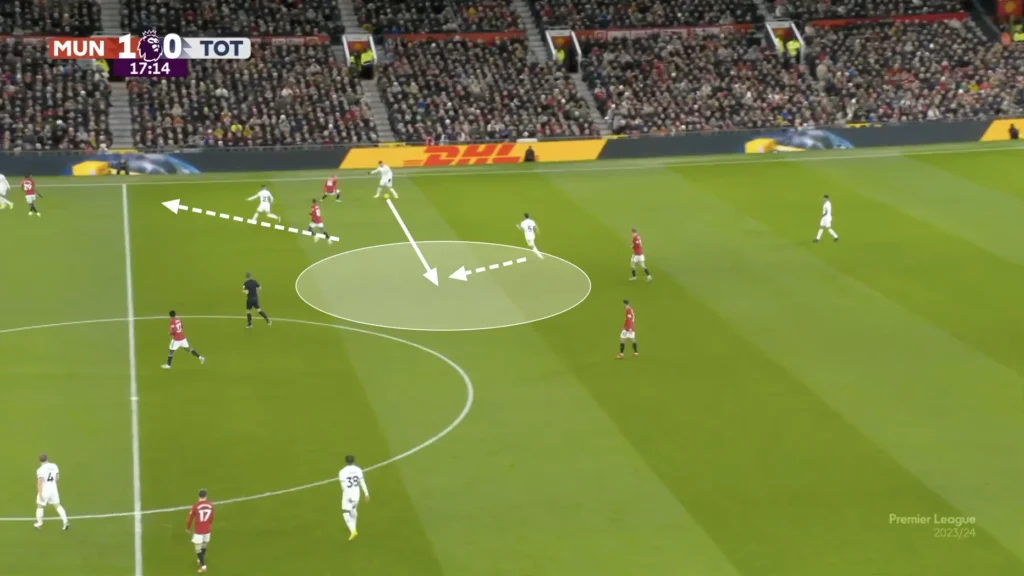
Follow Pressure
A tool for the Tottenham players in playing past the opposition in the build-up is to follow the pressure. This means running into the space that a pressing player is leaving behind. The space that opens is often the one behind the pressing winger, who pushes up on the center-back. The midfielder runs into that space, receiving the ball, turning, and progressing the ball up the pitch.
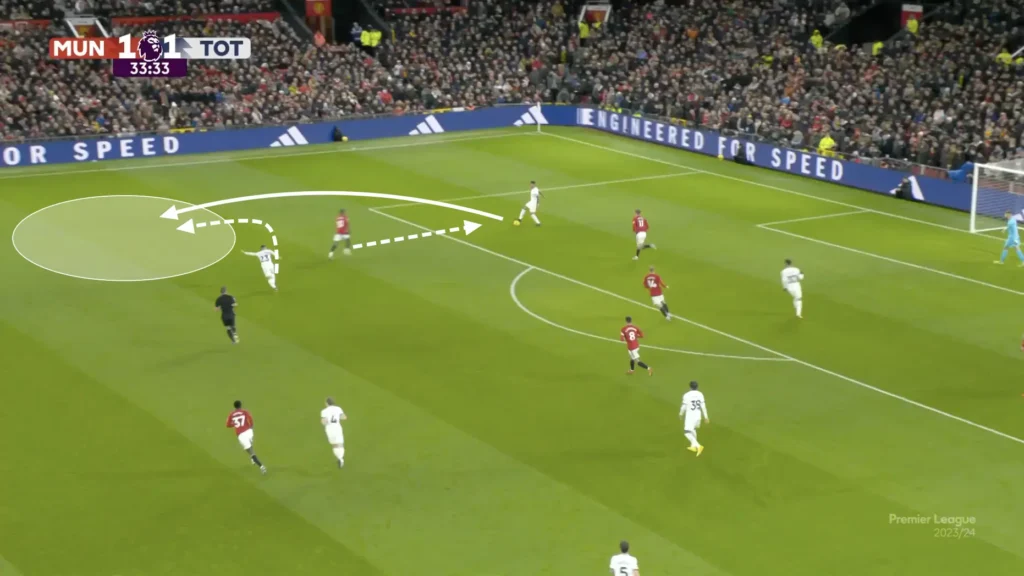
Third Man
Ange Postecoglou, as established, likes it when his team plays through the opposition. One vital tool that they often use is the third-man principle. This means using a third player to reach a free player whose passing lane is blocked.
They do this both in the low build-up:
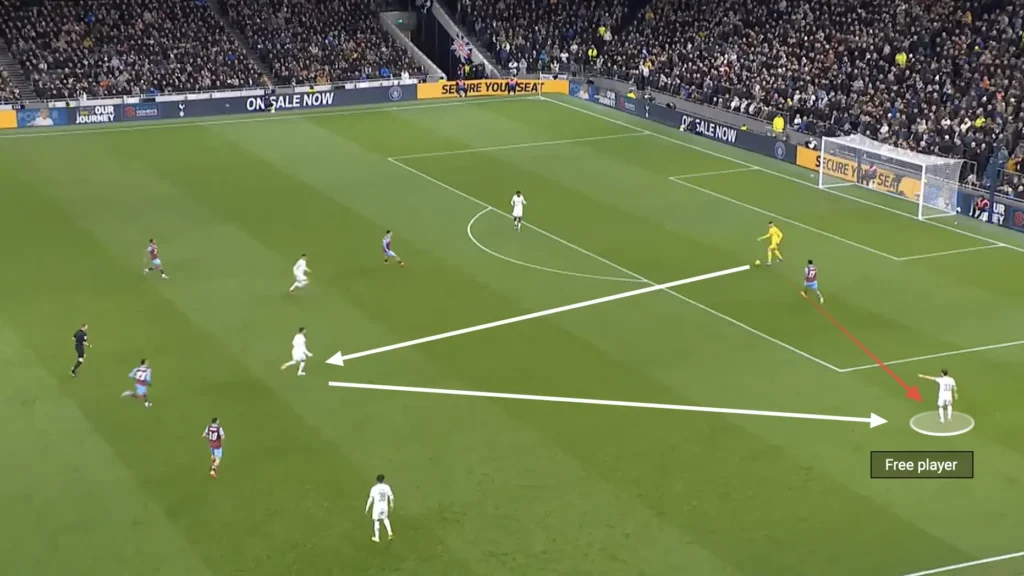
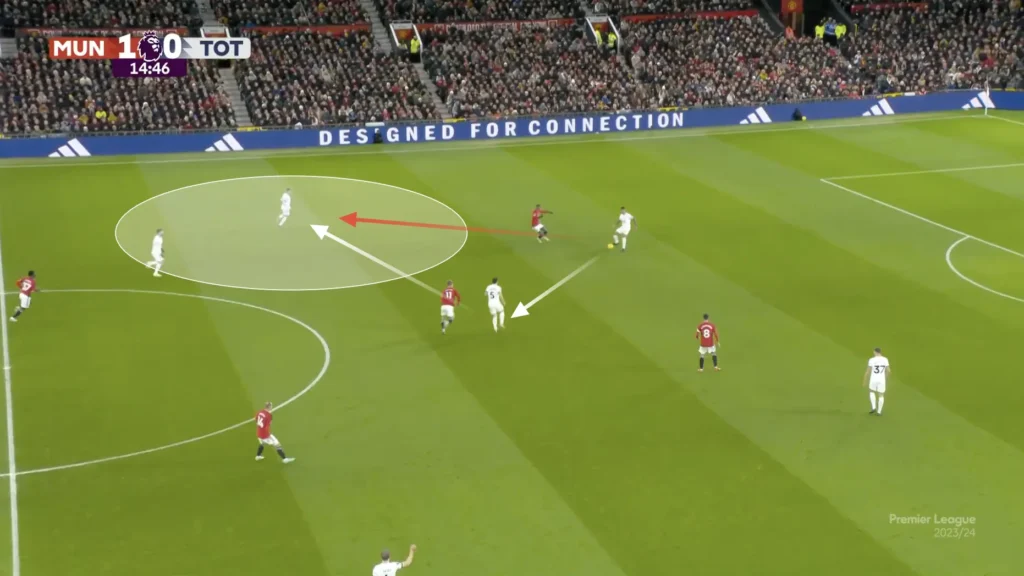
And in the high build-up:
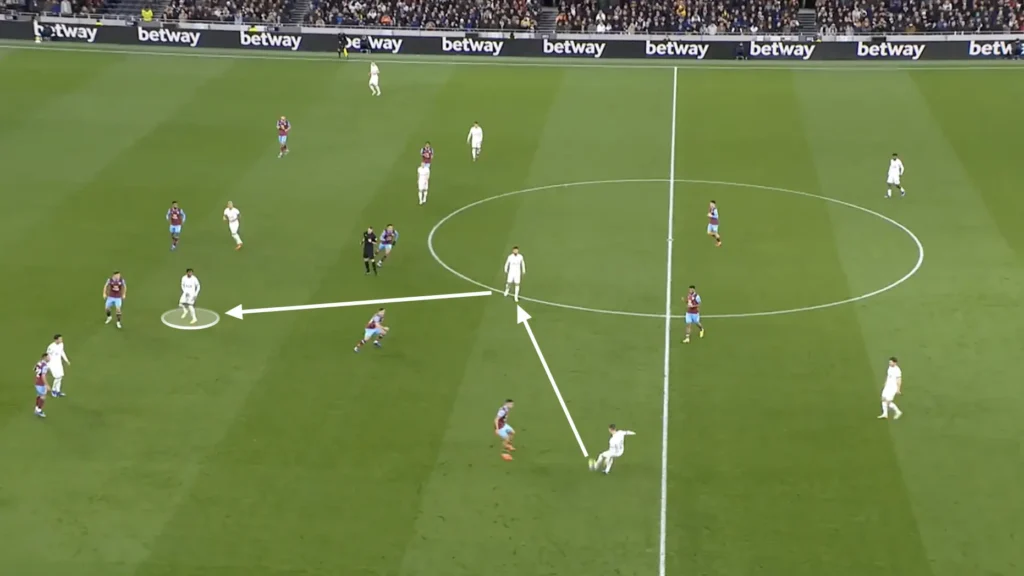
Defending
Low Press
In the low press, Tottenham use a 1-4-1-4-1 formation. They often set up in a mid-block, always trying to stay compact while closing the center, forcing the opposition out wide.
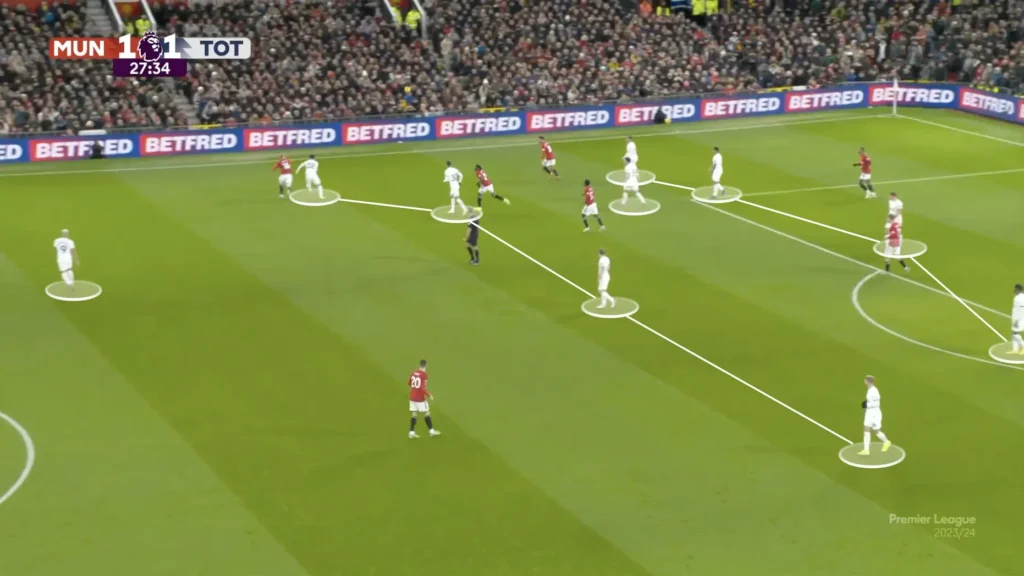
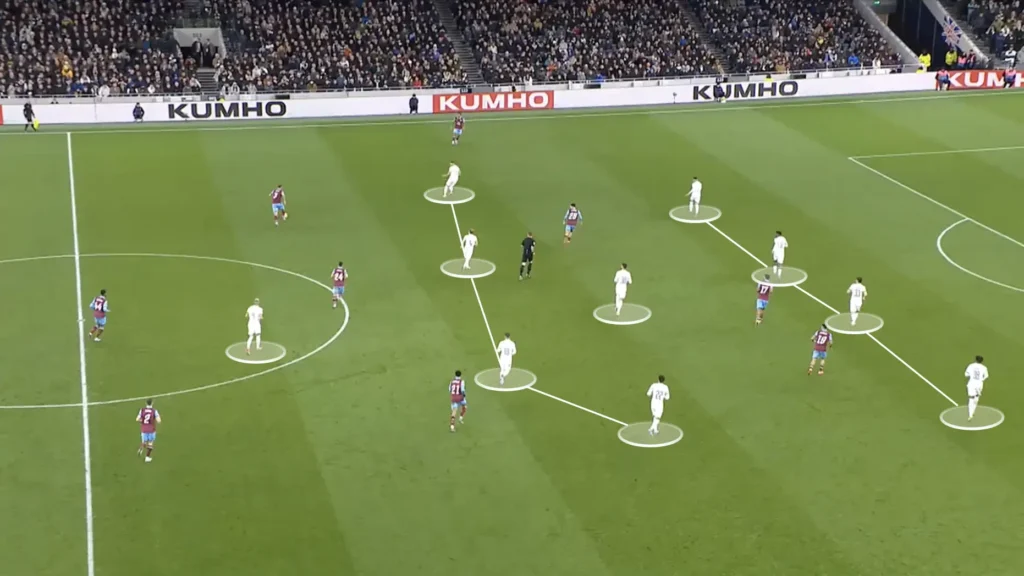
One tool that helps to be compact is to play with a high backline, making the space to the midfield line as small as possible. Postecoglou wants his team to do this, and they try to keep the highest line they can without leaving the space behind them too open.
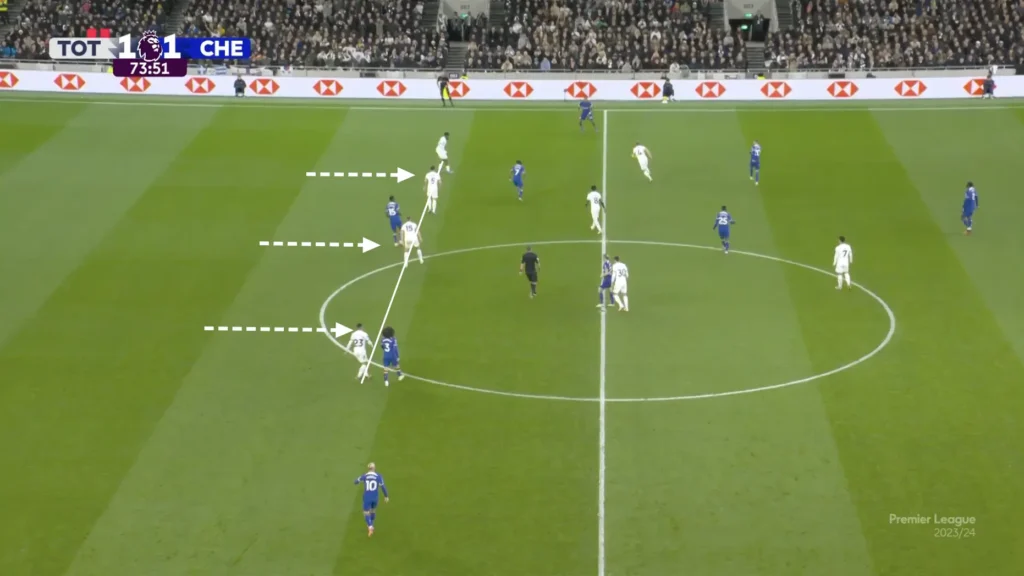
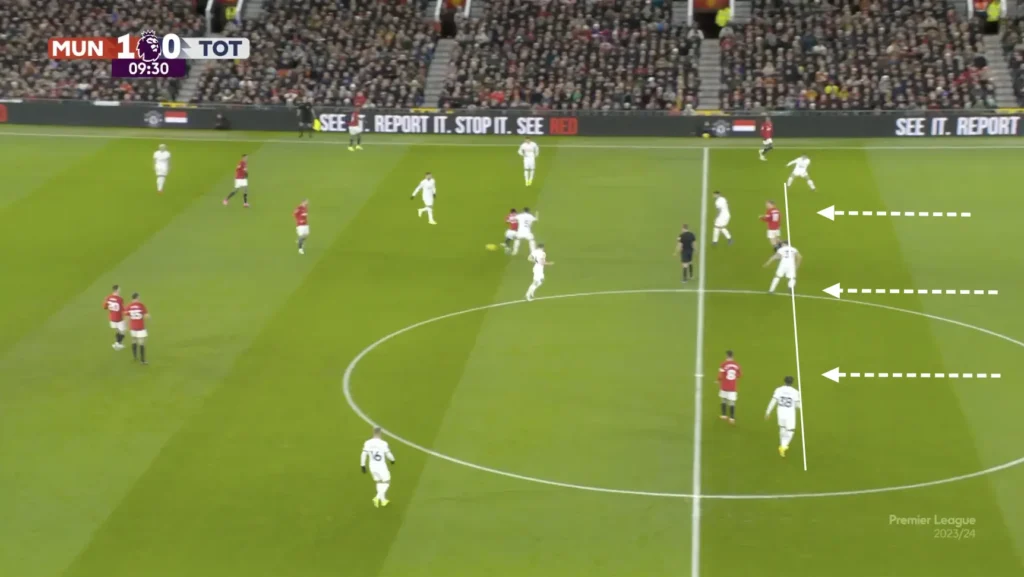
An important aspect of keeping a high line is to have a goalkeeper who can deal with the through-balls behind the backline. This is called a sweeper-keeper. Vicario is great at this and always comes out and clears the dangerous through-balls.
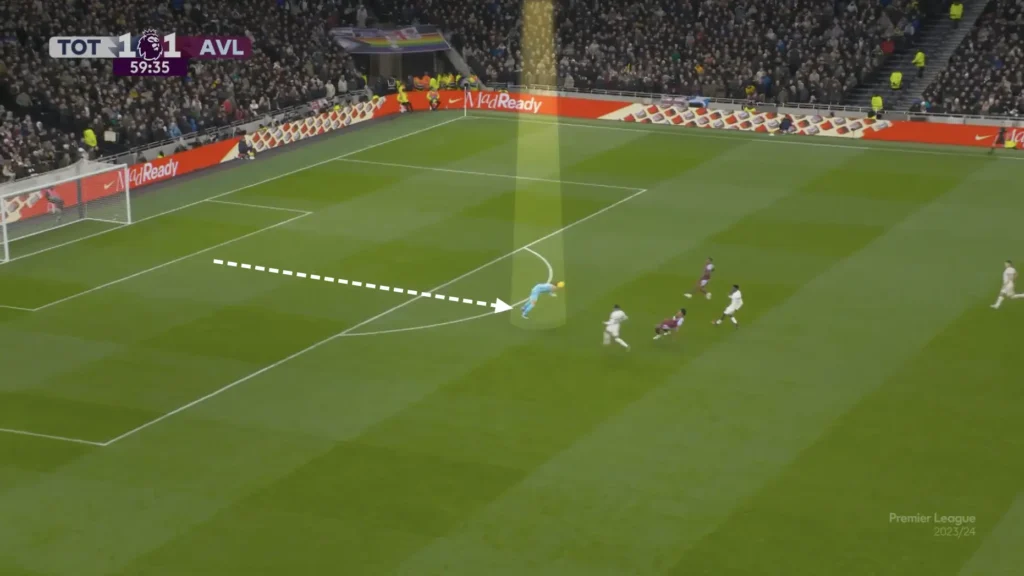
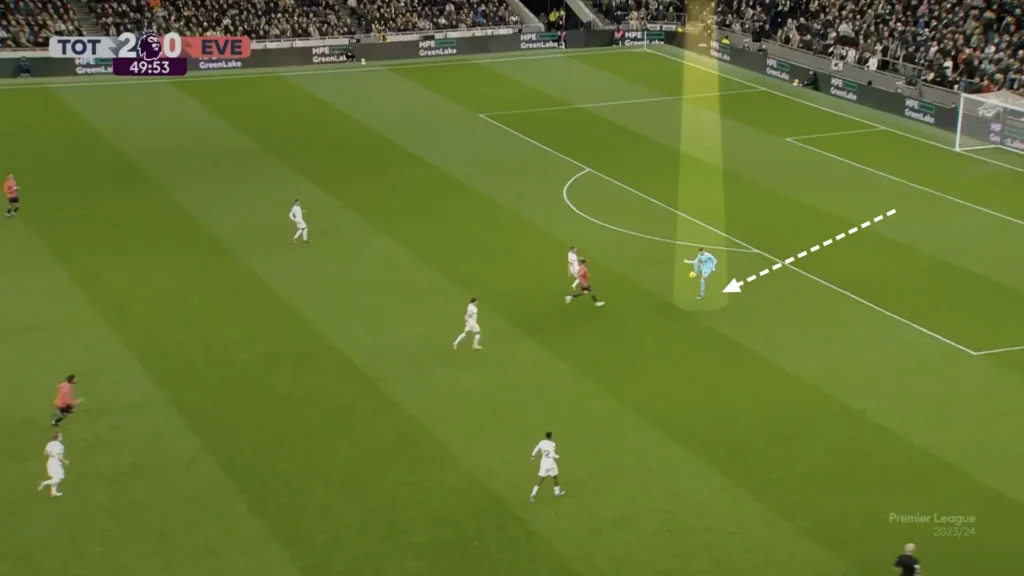
High Press
Postecoglou places much value in being aggressive without the ball. This shows in Tottenham’s high pressure. Postecoglou usually wants his team to go man-to-man and intensely press the opposition. They do this because they always look to have possession. Tottenham are also good at overloading the ball side. They get many players into the press, suffocating the opposition and forcing them to give the ball away.
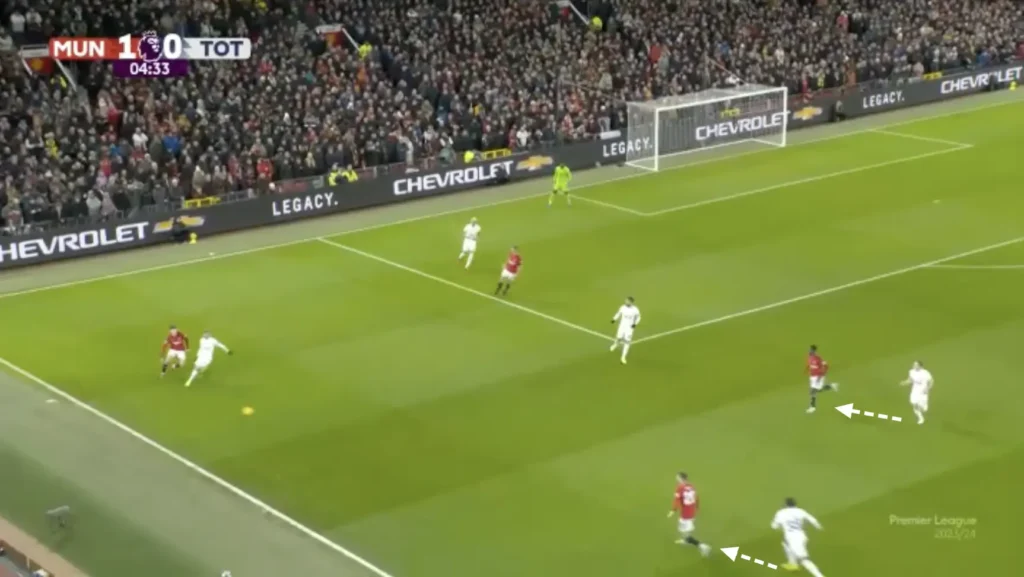
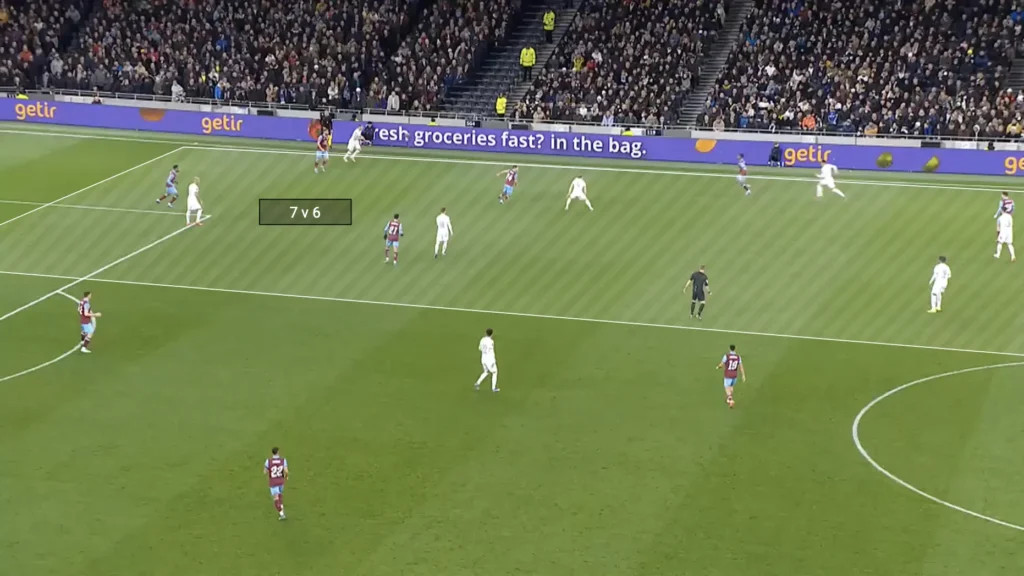
Defensive Transitions
Positioning many players centrally, creating a numerical advantage in the midfield, creates good conditions in defensive transitions. Many players close to the ball after losing possession means that many players can work towards regaining possession. Tottenham, therefore, often regains possession directly after losing it.
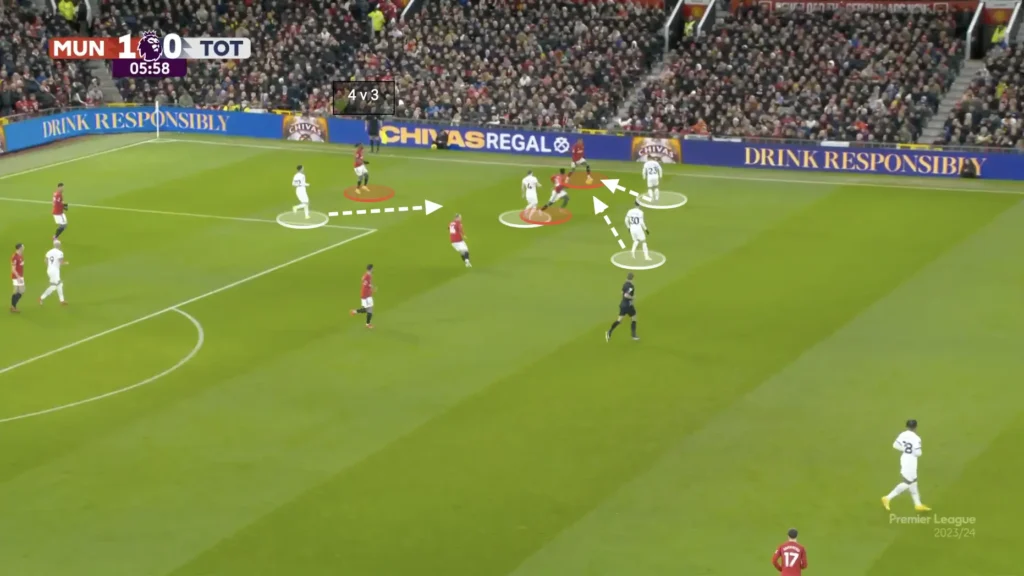
Weaknesses
A significant weakness of Postecoglou’s Tottenham is that they sometimes are very open to counterattacks. Keeping players in central and offensive positions during the high build-up usually helps in the counterpress. If they, however, do not regain possession during the counterpressing phase, they often open up opportunities for dangerous counterattacks. Tottenham having inverted fullbacks leaves the space outside the center-backs open, sometimes causing problems for Ange Postecoglou’s team.
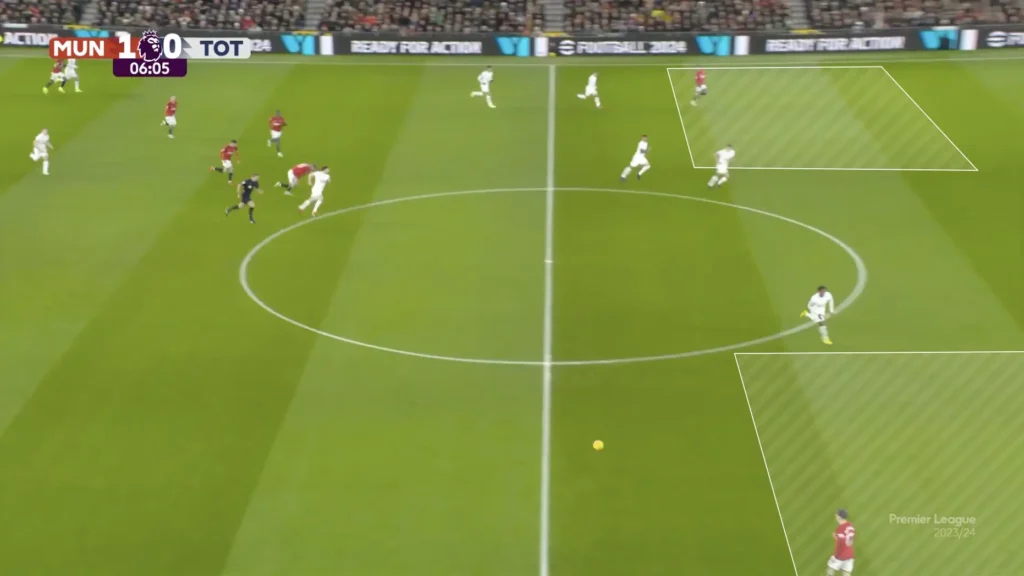
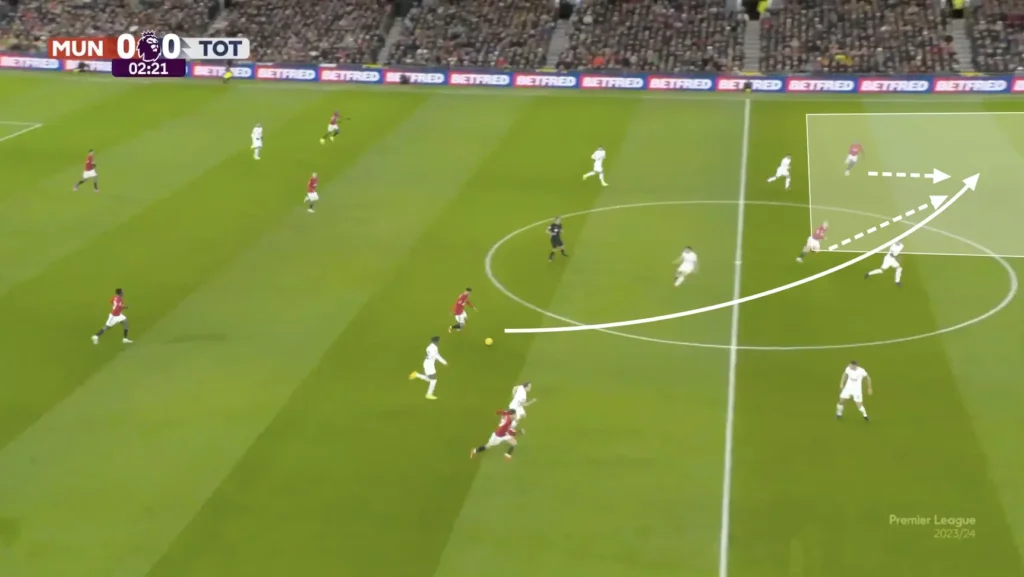
Another weakness of Tottenham is that they, at times, lose their compact defensive shape and allow the rival team to find open players between the lines. The players on the opposite side from the ball can lose focus and become more careless in defense, leaving the opposition ways to play through Tottenham’s defense.
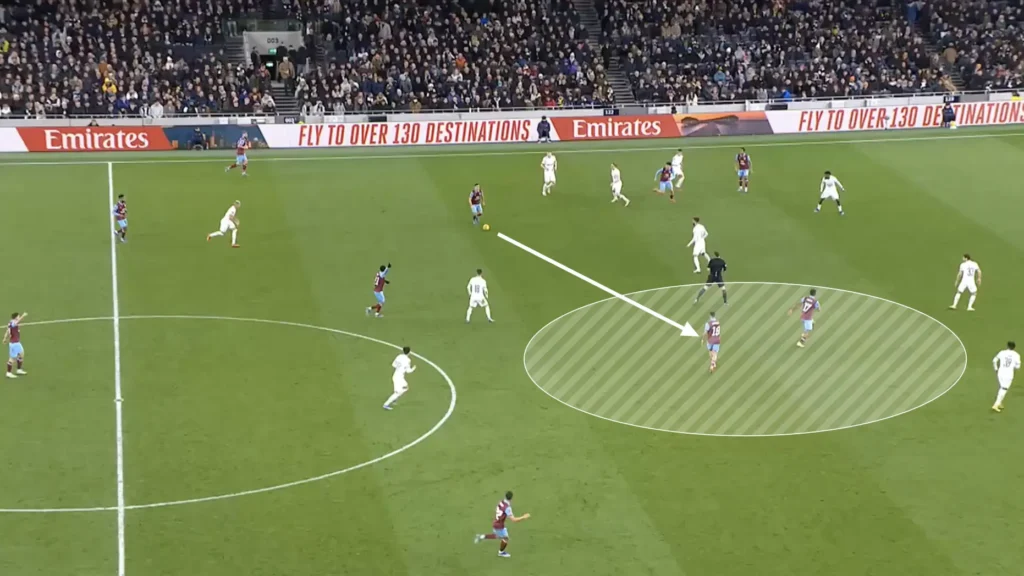
Final Thoughts
In conclusion, this tactical analysis of Ange Postecoglou’s strategies with Tottenham reveals a dynamic and adaptive approach that has significantly influenced the team’s playing style. From a fluid build-up to creative positioning, Postecoglou has instilled a sense of versatility in Tottenham’s tactics. The emphasis on a high backline, fluid movements, and quick transitions showcases his commitment to an attacking brand of football. While there are defensive challenges, particularly in managing spaces on counterattacks, the overall impact of Postecoglou’s tactical approach is evident. As he continues implementing his vision, Tottenham fans can expect an exciting evolution in the team’s playing philosophy under his guidance. This analysis not only sheds light on the current state of Tottenham’s tactics but also provides a glimpse into the potential directions the team may take under the strategic leadership of Ange Postecoglou.
